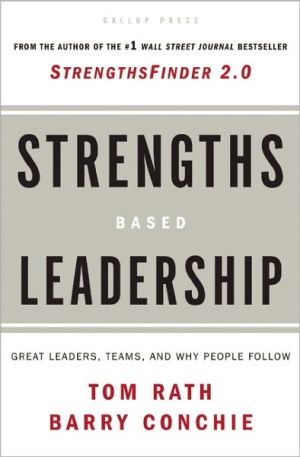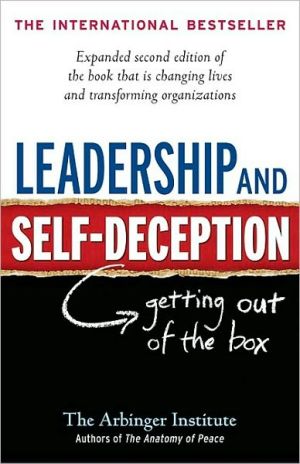The Courageous Follower: Standing Up to & for Our Leaders
Many significant failures-from FEMA's response to Hurricane Katrina to the recent economic collapse-could have been prevented or mitigated if those lower in the hierarchy were successful at communicating to leaders the risks they saw in the system. Ira Chaleff's Courageous Follower model has facilitated healthy upward information flow in organizations for over fifteen years. The Harvard Business Review called Chaleff a pioneer in the emerging field of followership-this new edition shares his...
Search in google:
Many significant failures-from FEMA's response to Hurricane Katrina to the recent economic collapse-could have been prevented or mitigated if those lower in the hierarchy were successful at communicating to leaders the risks they saw in the system. Ira Chaleff's Courageous Follower model has facilitated healthy upward information flow in organizations for over fifteen years. The Harvard Business Review called Chaleff a pioneer in the emerging field of followership-this new edition shares his latest thinking on an increasingly vital topic.The updated third edition includes a new chapter, "The Courage to Speak to the Hierarchy." Much of Chaleff's model is based on followers having access to the leader. But today, followers can be handed questionable policies and orders that come from many levels above them-even from the other side of the world. Chaleff explores how they can respond effectively, particularly using the power now available through advances in communications technology.Everyone is a follower at least some of the time. Chaleff strips away the passive connotations of that role and provides tools to help followers effectively partner with leaders. He provides rich guidance to leaders and boards on fostering a climate that encourages courageous followership. The results include increased support for leaders, reduced cynicism, and avoidance of serious organizational missteps.
The Courageous Follower\ STANDING UP TO & FOR OUR LEADERS \ \ By IRA CHALEFF \ Berrett-Koehler Publishers, Inc.\ Copyright © 2009 Ira Chaleff\ All right reserved.\ ISBN: 978-1-60509-582-0 \ \ \ Chapter One\ THE DYNAMICS OF THE LEADER-FOLLOWER RELATIONSHIP \ I USED TO HAVE ASPIRATIONS to work closely with prominent leaders but found that when I was actually with them, I would clutch, become tongue-tied, or engage more in flattery than dialogue. In doing this, I wasted whatever opportunity there may have been to develop a meaningful relationship with the leader in which we learned from each other.\ When still in the "aspiring" state, I would look forward to being seated at the same table as the head of the organization at a company banquet. Later, as I discovered my nervousness about the interaction, I purposely avoided this close contact. Yet a colleague of mine, who was affable but not normally ingratiating, always aggressively sat himself next to the president of the company if he could. He was incredulous that others did not fight for the opportunity to bring themselves to the president's attention. For both my colleague and me, the mere fact of close contact with the leader produced changes in how we usually behaved with other people.\ As a leader myself, I observed who would influence me and whom I was prone to ignore or dismiss. The people who influenced me from a lateral or subordinate position seemed to have a deep, natural sense of self-worth. They needed this quality because at times I could present a pretty gruff image, which would intimidate a less confident person. They were able to separate out this aspect of my personality and not interpret it as their own failing. They knew their specialties, observed and respected my strengths, supported my efforts, and spoke to me forthrightly when they thought I was off the mark. They also cared as much as I did about the organization's purpose and our success in achieving it.\ In this chapter I examine the challenges we face in establishing and maintaining a true relationship with a leader. By "true," I mean a relationship in which we can comfortably meet a leader as one human being to another. In a true relationship, we are neither retiring nor fawning nor manipulative. We work together with mutual respect and honesty to achieve our common purpose.\ THE COMMON PURPOSE AND CORE VALUES\ Any organization is a triad consisting of leaders and followers joined in a common purpose. The purpose is the atomic glue that binds us. It gives meaning to our activities.\ Followers and leaders both orbit around the purpose; followers do not orbit around the leader.\ Often the purpose exists and we come together around it. Some times the leader envisions it and draws us to it. At other times we formulate or redefine the purpose together. If the purpose is not clear and motivating, leaders and followers can only pursue their perceived self-interest, not their common interest. The process of clarifying purpose can mobilize a group, heal painful rifts, and help the group steer through treacherous passages. It is a critical act of strong leadership and courageous followership.\ Equally fundamental are the group's shared values. Clarifying core values validates the purpose and determines how we will and how we won't pursue it. If the purpose is pursued in the context of decent human values, it serves as a guiding light in navigating our relationship with a leader. If the purpose intrinsically violates or is pursued in a way that violates decent human values, however, it is not an ethically valid guide. For example, "making a profit for shareholders" is a purpose we can use to guide our actions. "Making a profit regardless of the impact on the community or environment" nullifies its validity in determining appropriate action.\ A common purpose pursued with decent values is the heart of the healthy leader-follower relationship.\ THE PARADOX OF FOLLOWERSHIP\ We are responsible. Whether we lead or follow, we are responsible for our own actions, and we share responsibility for the actions of those whom we can influence.\ All important social accomplishments require complex group effort and, therefore, leadership and followership. Both are necessary in the pursuit of a common purpose. Some believe that influence in the leader-follower relationship is largely one-way. This is far from true. Followers have great capacity to influence the relationship.\ Just as a leader is accountable for the actions and performance of followers, so followers are accountable for their leaders. We must support leaders and, when necessary, help them correct their actions, just as they must support us and help us correct our actions. This is partnership. Both sides must be proactive. If we have followers who are partners with leaders, we will not have leaders who are tyrants.\ Leadership may be informal and distributed throughout an organization. But formal leadership, which has final accountability and authority, is usually vested in an elected or appointed or self-proclaimed leader or small group. At the extremes, the formal leaders of a group may be wise or arrogant, servants or parasites, visionaries or demagogues. More commonly, leaders are a rich blend of strengths and weaknesses, of qualities that add and subtract value, and there is the potential for either side of their personalities to grow while in office. The quality and courage of followers influence which of the leader's characteristics will grow.\ If we amplify our leaders' strengths and modulate their weaknesses, we are the gem cutters of leadership, coaxing out its full brilliance. If we amplify our leaders' weaknesses, we may stress existing fracture lines in their characters, and these fracture lines may become fatal flaws. Followers who are closest to a leader carry pivotal responsibility; they markedly shape the tone and outcomes of a leader's tenure.\ Courageous followership is full of paradox:\ A courageous follower has a clear internal vision of service while being attracted to a leader who articulates and embodies its external manifestation.\ Courageous followers remain fully accountable for their actions while relinquishing some autonomy and conceding certain authority to a leader.\ A central dichotomy of courageous followership is the need to energetically perform two opposite roles: implementer and challenger of the leader's ideas.\ There is inherent tension between the identity a follower derives from group membership and the individuation required to question and creatively challenge the group and its leadership.\ Followers often benefit from the leader as mentor, learning crucial things, yet at the same time must be willing to teach the leader.\ At times, courageous followers need to lead from behind, breathing life into their leader's vision or even vision into the leader's life.\ Senior followers often are important leaders in their own right and must integrate within themselves the perspectives of both leadership and followership.\ The concept of a "courageous follower" appears to some to be an oxymoron but, if embraced, enables followers to join leaders fully as stewards of the group's trust.\ WHO DOES A FOLLOWER SERVE?\ Follower is not synonymous with subordinate. A subordinate reports to an individual of higher rank and may in practice be a supporter, an antagonist, or indifferent. A follower shares a common purpose with the leader, believes in what the organization is trying to accomplish, wants both the leader and organization to succeed, and works energetically to this end.\ Like the leader, the follower is a steward of the resources an organization can draw on to carry out its work. The resources of a group include its leaders. Thus, a follower is a leader's steward every bit as much as a leader is the follower's steward.\ We can perform our role as followers at different levels:\ At the purest level, we serve those whom the organization exists to serve—its members, clients, constituents, customers, communities—often called stakeholders because of their stake in the outcome of the group's actions.\ Below that, and quite functionally, we simultaneously serve the organization's stakeholders, its leaders, and ourselves, with no conflict of interest. Below that, we serve the leaders and ourselves but not the stakeholders. While we may be rewarded for this in the short run, we sow the seeds of the organization's failure.\ At the lowest level, we serve the leaders while permitting them to harm the organization and its stakeholders through corruption, and we participate in that corruption ourselves.\ If we serve only ourselves and not the leaders or the stakeholders, we are not followers but opportunists siphoning off the energy of the group to serve our own agendas.\ SELF-INTEREST AND COMMON PURPOSE\ True leaders and followers are dedicated to the common purpose. At the same time, other than in rare cases of idealism and self-sacrifice, leaders and followers also bring their self-interest to the relationship and their work.\ There is nothing inherently problematic about self-interest as long as it does not eclipse the common purpose. There is tremendous energy generated in the pursuit of self-interest. It is energy that if properly aligned brings great value to the organization.\ Leaders who remain aware and supportive of the self interest of their followers generate loyalty and commitment. It is similarly valuable for followers to remain aware of the self-interest of leaders. What are their aspirations? What would help a leader realize the aspiration? What would jeopardize the dream?\ There are many priorities and voices competing for leaders' attention. To sufficiently interest leaders in adding another item to their overflowing plates, it is sometimes necessary to frame the matter in terms of both purpose and aspirations.\ Similarly, while pursuing one's own interests, followers need to stay self-aware that these align with the mission, rather than compete with it. Honest self-appraisal is required for appropriate balance. Be careful here. It is human to rationalize. Courageous followership demands rigorous self-honesty.\ We have the right to be advocates for our self-interest within service to the purpose. We can ask for support and, within reason, expect to receive it. We do not have the right to manipulate the leader and group to serve our self-interest at the expense of the common purpose.\ LOYALTY OF A FOLLOWER\ In the past, when relationships were more stable and lifelong social contracts were the norm, loyalty was unquestioningly given—to the clan, to the feudal lord, to the sole employer. Unquestioning loyalty is, of course, fraught with moral peril. Today, relationships are constantly shifting and loyalty is problematic—who deserves it and why? Yet the lifting of cultural pressure to give blind loyalty allows us the freedom to make conscious moral choices based on our core values.\ Placing our loyalty somewhere is an important act of identity. We can place it in ourselves, and often this is important to help us stay a difficult course. But if we place no loyalty outside ourselves, we become a kind of brigand, justifying any action regardless of its cost to others.\ Leaders and followers who find themselves in constantly shifting configurations need to find a mutual place for their loyalty that transcends the impermanence of their relationship yet bonds them in a framework of trust. This is the importance of the contemporary emphasis on vision, values, and mission statements: well formulated, these define the loyalty that leaders and followers pledge to those who have a stake in the group.\ The values statement evokes a circumscribed loyalty—to fairness, to quality, to honesty, to service, to a common purpose. Circumscribed loyalty to worthy values avoids the pitfalls of unlimited loyalty and may be an evolutionary step forward. Both leaders and followers are entering into a contract to pursue the common purpose within the context of their values. The loyalty of each is to the purpose and to helping each other stay true to that purpose.\ If leadership and followership are both forms of stewardship, then loyalty is correctly directed to the organization's purpose and its stakeholders. It appropriately includes and embraces the principles, people, and environments affected by the organization's actions. Once appropriate loyalty is clarified, it can inform our decisions to support or challenge a leader's agenda.\ POWER IN THE LEADER-FOLLOWER RELATIONSHIP\ Wherever an organization lies on the spectrum from "hierarchical" to "shared" leadership, some power is always vested in the leaders and some in the followers. In shared leadership, the power is more balanced although one faction may accumulate power over other factions. In an autocratic hierarchy, power appears to reside almost entirely with the leader until something occurs that causes the followers to depose the leader and reclaim their power.\ The situation in which power appears to reside entirely with the leader is very dangerous both for the follower, who can be ruined at the leader's whim, and for the leader, whose followers become sycophantic. Sycophants act according to what they have learned is expected of them in a situation. They do not observe or think well for themselves, and often fail to take appropriate actions. This hurts the leader and the organization.\ As followers, our formal powers are unequal to the leader's, and we must learn to participate effectively in the relationship despite this imbalance. We may have far more power than we imagine, however, and too often fail to exercise the power we do have. It is critical for followers to connect with their power and learn how to use it. To maintain and strengthen power, it must be used; otherwise, it will wither.\ The sources of a follower's power are varied:\ The power of purpose, the strength that comes from commitment to the common good\ The power of knowledge, the possession of skills and resources the organization and its leadership value and do not want to lose\ The power of personal history, a record of successes and unassailable contributions to the leader and the organization\ The power of faith in self, belief in our observations and intentions, in our integrity and commitment\ The power to speak the truth, as we see it, to the leadership\ The power to set a standard that influences others, to model values and behavior for the leader and group members\ The power to choose how to react in a situation regardless of what is done or threatened by others\ The power to follow or not follow in a given direction\ The power of relationships, of networks of people who know and trust us\ The power to communicate through a variety of channels\ The power to organize others of like mind\ The power to withdraw support if the leadership's actions violate our values\ If we are to be effective partners with leaders, it is important to remember that as followers we possess our own power, quite apart from the reflected power of the leader.\ VALUE OF THE FOLLOWER\ Follower is not a term of weakness but the condition that permits leadership to exist and gives it strength. Dynamic followers recognize their own aspirations in the leader's vision. They follow their own light, which the leader intensifies. They give 110 percent, not because the leader "motivates them" but because they are inspired—the spirit of the activity is within them. They are interdependent with, not dependent on, the leader. They add value to both themselves and the leader through this relationship.\ The value of a follower is measured by how completely the follower helps the leader and organization pursue their common purpose within the context of their values. Certain characteristics help to do this:\ Effective followers are cooperative and collaborative, qualities essential to all human progress.\ Trusted followers integrate their ego needs sufficiently into their communal responsibilities to serve rather than compete with the leader.\ (Continues...)\ \ \ \ \ Excerpted from The Courageous Follower by IRA CHALEFF Copyright © 2009 by Ira Chaleff. Excerpted by permission of Berrett-Koehler Publishers, Inc.. All rights reserved. No part of this excerpt may be reproduced or reprinted without permission in writing from the publisher.\ Excerpts are provided by Dial-A-Book Inc. solely for the personal use of visitors to this web site. \ \
Preface to Third Edition xiiiPreface xviiIntroduction 1The Five Dimensions of Courageous Followership 61 The Dynamics Of The Leader-follower Relationship 11The Common Purpose and Core Values 12The Paradox of Followership 13Who Does a Follower Serve? 15Self-interest and Common Purpose 16Loyalty of a Follower 17Power in the Leader-Follower Relationship 18Value of the Follower 19Courage of the Follower 20Balance through Relationship 22Mature Relationships 24Differences in Elevation 25Finding Equal Footing with the Leader 26When the Leader Isn't an Equal 27Trust 29Followers as Leaders 30Working with Other Followers 312 The Courage To Assume Responsibility 35Self-Assessment 38Followership Style 39Eliciting Feedback 43Personal Growth 44Self-Management 45Taking Care of Ourselves 46Passion 48Initiative 49Influencing the Culture 50Breaking the Rules 51Breaking the Mind-set 52Improving Processes 53Testing Your Ideas 543 The Courage To Serve 57Conserving a Leader's Energy 59Organizing Communication Processes 60Acquiring Access 61The Responsibilities of Gatekeeping 62Buffering a Leader 64Defending the Leader 65Buffering Others from a Leader 66Acting in the Leader's Name 67Defining a Leader Publicly 68Focusing the Creative Leader 69Presenting Options 70Knowing When You Don't Know 72Avoiding Insularity 73Encouraging Peer Relations 74Managing Crises 76When the Leader Is 111 77Conflict between Leaders 79Formal Checkups 80Building Relationships with Leaders 814 The Courage To Challenge 85Effective Leadership Behavior 88Preparing a Leaderfor Feedback 89Giving a Leader Feedback 91Giving a Leader Input 93Challenging Indirectly 94Avoiding Knee-jerk Rejection 95Overcoming Groupthink 96The Duty to Obey 98Challenging Abuse Early 99Challenging the Use of Language 101Arrogance 102Leaders Who Scream 103Personal Issues 106Newly Elevated Leaders 106Leaders Who Have Other Agendas 108Leaders Who Won't Challenge Their Leaders 109Challenge Yourself, Too 1115 The Courage To Participate In Transformation 113When Is Transformation Possible? 120The Process of Personal Transformation 120The Follower's Role 123The Follower as Catalyst 124Channeling the Leader's Frustration 126Denial and Justification of Behavior 127Dedication to Cause as Justification 128Reactions to Confrontation 129Identifying Transformation Resources 131Using an Outside Facilitator 132Creating a Supportive Environment 134Modeling Change for a Leader 135Modeling Empathy 136Containing Abusive Behavior 138Positive Reinforcement 140Coping with Recurring Behavior 140Realistic Expectations 142Persistence 143Validation 1446 The Courage To Take Moral Action 147Leaving 151Difficulty of Separation 153Financial Contingencies 155Offering to Resign 157Query and Appeal 158The Duty to Disobey 162Threatening to Resign 164The Dilemma of the "Unreasonable" Leader 165Values Review 166Follower Self-Examination 167The Decision to Withdraw Support 168The Responsibility to Blow the Whistle 170Protecting Yourself 172When Leaders Must Be Opposed 173Evil Behavior 175If We Decide to Stay 1777 The Courage To Speak To The Hierarchy 179The Challenge of Many Hands 184Doing the Homework 186Framing the Issue to Command Attention 188Educating the Hierarchy 190Circumventing the Hierarchy 192Speaking Up in Multilevel Meetings 194Finding Formal Platforms of Influence 196Using Informal Platforms of Influence 198Influencing the Metrics That Influence Thought 201Patience, Performance, and Persistence 2038 The Courage To Listen To Followers 205Do You Really Want Courageous Followers? 208What Messages Are Number Twos Sending? 212Appreciating and Accepting Support 213Appreciating Constructive Challenge More 215Inviting Creative Challenge 218A Culture of Communication, Not Complaints 220Creating Protected Communication Channels 222Discernment: What Is the Right Action? 224The Role of the Board 227Responding to a Moral Stand 230Growth as Both Leader and Follower 232Epilogue 235Meditation on Followership 237Acknowledgments 239Select Bibliography 243Index 253About the Author 263








